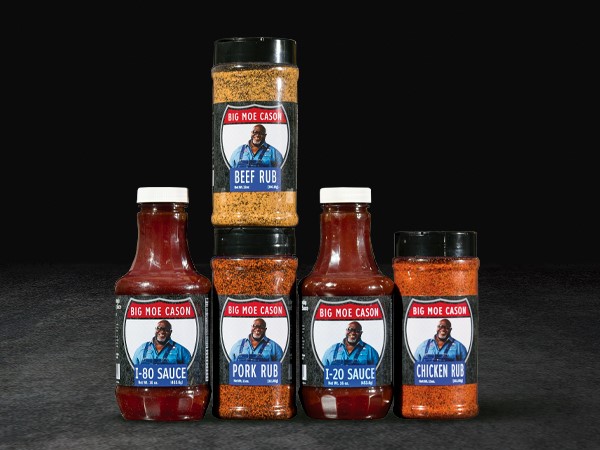Description
Barbecue pitmaster Moe Cason made his name competing in multiple national cook-offs and TV shows. But his love of cooking—and especially cooking with fire—started in Des Moines, Iowa, where he was born and raised. Even his stint in the Navy included working in the fire room.
After leaving the Navy, Moe cooked in his backyard for years before entering his first competition in 2006. He has since participated in more than 300 competitions and has racked up numerous awards, including multiple Grand and Reserve Grand Championships.
Now he's revealing his greatest barbecue tips and how to use his sauces and rubs, available at Hy-Vee. Shop our favorite barbecue ingredients!
There’s even more in the digital edition of Seasons magazine! Keep getting to know Moe.
Invest in the Tools of the Trade
Every great barbecue pro should have these tools:
- Weber Chimney Starter for getting hot coals fast.
- Weber Instant-Read Thermometer for accurate temping.
- Weber Premium Tongs for turning meat with ease.
- Full Circle Hardwood Lump Charcoal to start grilling quickly.
Know Your Equipment
"You need to master your pit," Moe says. "You need to know the ups and downs. You should be able to run that pit when it's 100 degrees outside or when it's 2 degrees outside."
It starts with a good-quality thermometer that tells you the correct temperature quickly.
"Every time you open the pit, you add 15 to 20 minutes' cook time," he adds. "If you're looking, you're not cooking."
Choose a Good Cut
Look for good marbling. "That's what's going to determine how flavorful that piece of meat is going to be," Moe says. "The striations of marbling you see, that is the love in that piece of meat. The more marbling you have, the more forgiving and the more flavorful that piece of meat is going to be."
We don't have to tell you that Hy-Vee beef is best! Our corn-fed beef has more marbling for more flavor. Plus, it supports our local corn growers.
Develop a Schedule
"Plan your work," Moe says. If you're having friends over for barbecue at 3 PM, you need to work backward to know when to put the meat on the smoker, and remember to factor in rest time.
When planning to put meat on, "Give yourself a little leeway in case you have a couple hiccups," Moe advises.
- Brisket takes about 30-60 minutes per pound to smoke at 225 degrees. With prep and rest time, it can take 18-20 hours.
- Chicken should be cooked at 270 degrees for about 45 minutes per pound.
- Ribs should smoke at 270 degrees for a couple hours unwrapped, then another couple hours wrapped in foil.
- Pork butt takes about 9 hours to cook and needs to rest for up to 2 hours.
- Sides like Hy-Vee baked beans and macaroni & cheese take half an hour.
Use Bona Fide Pitmaster Techniques
Smoke like Moe Cason in a few easy steps:
- Fat side down: Always cook beef like brisket fat side down so the fat has a chance to render, drip onto the coals, and rise back up to add flavor to your meat.
- Use paper: Don’t wrap meat completely in foil; it creates a steaming effect that lets all the juices escape.
- Use good charcoal: Good-quality fuel makes good-quality food. You can use either lump charcoal or briquettes. If your firebox is small, use lump, as it burns cleaner and hotter. If you have a big pit, you can use briquettes, but they produce a lot of ash. Be sure to clear the ash away.
Add Authentic Flavors with Sauces & Rubs

Moe can lend you a helping hand with his line of Big Moe Cason sauces and rubs:
- I-80: A little sweet, a little savory, with notes of Kansas City barbecue.
- I-20: Sweet with some black pepper for heat on the back end.
- I-10: Southern-style tomato, vinegar sauce with a hint of heat.
- I-70: Kansas City flavor with celery and molasses.
- Chicken: Savory with hints of sweetness.
- Pork: Savory notes that add texture.
- Beef: Mix of black pepper, garlic and salt.
- Texas Brisket: Classic flavor and texture.
- Steakhouse: Traditional flavor and texture.
You Can Turn Almost Any Grill into a Decent Smoker
"You can turn to what you have in your backyard to make some great barbecue," Moe says.
For charcoal grills, offset the coals to one side and cook the meat on the opposite side. You can even turn a gas grill into a smoker by only turning on the burners on one side and putting a smoke box on top with some wood chips.

